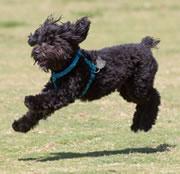 Little Portuguese water dogs make less growth factor than the big boys.Alamy
Little Portuguese water dogs make less growth factor than the big boys.AlamyA single gene may explain the vast size difference between that tiny terrier yapping in the park and the massive mastiff ignoring the din.
Nate Sutter, a geneticist at the National Human Genome Research Institute in Bethesda, Maryland, wanted to know the reason why big dogs, such as Irish wolfhounds, can grow up to 50 times larger than other members of their own species, such as chihuahuas. So he started out looking at large and small dogs of one breed — the Portuguese water dog.
Scientists on the team took X-rays of 500 Portuguese water dogs and made 91 measurements of their skeletons. Based on these data, the researchers classified the water dogs as either big or small for their own breed.
They then looked for differences in DNA between the large and small water dogs. This is a relatively easy job: a consortium of scientists including Sutter published the DNA sequence of the dog genome last December, and have mapped out the places where there is a lot of variation between individuals in a given breed. There are fewer of these places of variation in purebred dogs than there are in humans.
The team found that one of the few differences in these Portuguese water dogs occurred in a gene called 'insulin-like growth factor 1', or Igf-1.
This is one of many genes already known to influence the size of mice: when Igf-1 is knocked out, the animals grow up to be mini-mice. So the team wondered whether this gene was responsible for dog body size.
Great pomeranians?
To answer this question, scientists closely analysed the Igf-1 genes in 75 Portuguese water dogs and 350 other dogs of very large and very small breeds — from pomeranians and Yorkshire terriers up to great Danes and St Bernards. They also examined the gene in wild dogs, such as wolves and foxes, who are distantly related to domestic dogs.
They found that almost all of the 18 small breeds carried the identical variant of the gene as small Portuguese water dogs. But almost none of the 15 giant breeds carried this gene variant. That suggested that the gene plays a major role in controlling dog body size, Sutter said on 11 October at the annual meeting of the American Society of Human Genetics in New Orleans, Louisiana.
If researchers want to make a giant chihuahua, they now know where to start.
The gene seems to work by setting how much of the growth factor dogs make. In Portuguese water dogs, smaller animals make less of the growth factor than big ones.
The 'small' version of Igf-1 seems to have formed long ago, Sutter says. When humans began breeding tiny dogs, they inadvertently selected for this version of the gene, and over time the breeding process fixed the 'small' variant into tiny dog breeds.
Man's best friend
The study proves how useful genetic studies in dogs can be, Sutter says. Because dog breeders know the history of individual dogs in a breed, and because the dogs are purebred — meaning they have lost a lot of their genetic variation — it is easier to uncover the genetic causes of traits such as body size than it is in people.
ADVERTISEMENT
Other members of Sutter's group, led by Elaine Ostrander, are also looking for genes that cause diseases including cancer. Sutter says he hopes that they will find similar success.
"The power in dog populations is that they can deliver a simple genetic story about a precise genetic trait," Sutter says. "I think we're also going to find this with other complex traits."
Visit our genebetweentinydogs_and.html">newsblog to read and post comments about this story.
